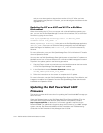
9-4 Dell PowerVault SAN Administrator’sGuide
Before you run the software upgrade from the latest
Dell PowerVault Fibre Channel
Utilities CD
or
Dell PowerVault Fibre Channel Update CD
, you must perform the fol-
lowing steps:
1. Back up your configuration data in the registry so that it is available after you com-
plete this process. Otherwise, it will be lost.
2. Uninstall the QLogic Fibre Channel Configuration Utility. For instructions, see
Chapter 11, “Installing, Configuring, and Removing Microsoft Windows
SAN Software Components.”
3. Uninstall the Dell PowerVault 5
x
F download utility.
a. Click Start—> Settings—> Control Panel.
b. Double-click Add/Remove Programs.
c. Highlight Dell PowerVault 5
x
F Utilities.
d. Click Add/Remove, and follow the instructions on the screen.
4. Uninstall all of the following software components.
a. Click Start—> Programs—> Dell OpenManage—> PowerVault
Manager—> Data Managed Node—> Data Managed Node Uninstall.
b. Click Start—> Programs—> Dell OpenManage—> PowerVault
Manager—> Data Supervisor—> Data Management Station Uninstall.
c. Click Start—> Programs—> Dell OpenManage—> PowerVault
Manager—> Data Administrator—> Data Administrator Uninstall,if
applicable.
d. Click Start—> Programs—> Dell OpenManage—> PowerVault
Manager—>DataAnalyzer—> Data Analyzer Uninstall, if applicable.
e. Click Start—> Programs—> Dell OpenManage—> PowerVault
Manager—> Power Tool—> Data Detective Uninstall, if applicable.
f. Click Start—> Settings—> Control Panel, double-click Add/Remove
Programs, select QLDirect, click Add/Remove, if applicable, and follow the
instructions on the screen.
g. Click Start—> Settings—> Control Panel, double-click Add/Remove
Programs, select Dell OpenManage ATF, click Add/Remove, and follow
the instructions on the screen.
h. Click Start—> Settings—> Control Panel, double-click Add/Remove
Programs, select Dell OpenManage Array Manager, click Add/Remove,
and follow the instructions on the screen.
NOTE: If you see error messages during any of the uninstall procedures, record
the error message and perform the failed task manually after you reboot the sys-
tem in step 5. For example, if the uninstall shield reports that files or directories
have not been deleted, open Windows Explorer and delete them after rebooting
the server.


















